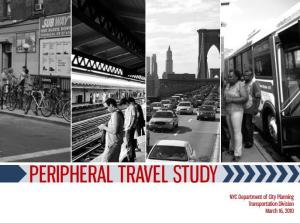Many Workers Travel To Manhattan, But More Stay in Their Boroughs
 Take that, Manhattan!
Take that, Manhattan!
The Department of City Planning published on its Web site today its 182-page Peripheral Travel Study—in an extensive effort to identify opportunities for short and long term strategic plans to address transportation needs in the boroughs outside of Manhattan.
What the report finds is that, while a lot of New Yorkers commute from outside the island to Manhattan jobs, more stay in their outer boroughs. More than 880,000 city residents do commute from the four boroughs into Manhattan, but more than 1 million workers live and work in the same borough in the Bronx, Brooklyn, Queens, and Staten Island. (Borough commuters into Manhattan join 628,000 workers who reside in Manhattan and another 540,000 from outside the city).
Despite the “common perception that most workers are concentrated in the Manhattan Central Business District (CBD), the opposite is true,” the report says.
Manhattan does have the greatest density of employment, and it does draw more workers from throughout the region than any other area. But more people live and work in the same borough than commute to any other. And excluding journeys to Manhattan, there were more than 323,000 interborough journeys-to-work, 44 percent of which where between Brooklyn and Queens.
Guess Manhattan isn’t as popular as people thought?
Though The Observer did not read the entire report, it seems that an important finding is that in the outer boroughs, people tend to work relatively close to their residence, and among those that work close to home in the same study area, non-automotive travelling is most popular. Future public policy, the report recommends, should explore ways to encourage workers living and working in the same area to avoid using their cars.
Another interesting factoid, among those working and living in the same borough, the predominant transportation mode in trendy Brooklyn is “Other” (which includes walking, biking, taxi, motorcycle, and work at home).
In the same category in Queens and the Bronx, the primary mode is, unsurprisingly, auto.
What neighborhood wins for highest mean travel time (still excluding Manhattan residents)? Sorry, Southeast Queens (48 minutes!), but that’s what you get for being so far away from major subway lines!
Fort Greene and Bay Ridge have the shortest mean travel times for work commutes—38.8 minutes—the study says.
What do these findings actually mean? The study says, “More than 300,000 people travel daily between the boroughs (other than Manhattan) to work. The automobile dominates this travel. Nevertheless, there may be opportunities to expand the use of alternative modes.”
Travel between Brooklyn and Queens has potential for growth, the study says. “These boroughs are adjacent and both bus service and bicycle improvements should be explored.”
Automobiles, though aren’t going anywhere soon. The study says in its conclusion, “Workers are coming from diverse locations which, at least to date, have made the automobile the most attractive means of commuting for many people.”
slevin@observer.com


